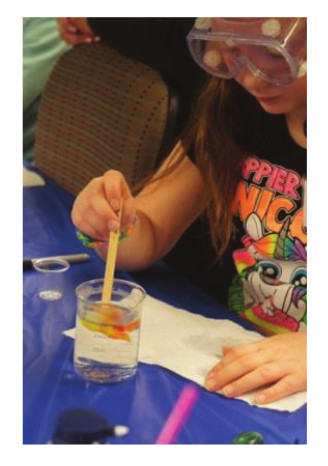 What’s more summery than watermelon? These fun lessons from the National Watermelon Promotion Board are perfect summer science activities and can be modified depending upon the grade range you’re teaching.
What’s more summery than watermelon? These fun lessons from the National Watermelon Promotion Board are perfect summer science activities and can be modified depending upon the grade range you’re teaching.
Summer Science Lesson
June 14, 2016Molding a Thermoplastic Polymer
June 10, 2016
By Dr. Kenneth Lyle, Duke University, Durham NC and Elaine “Lainey” Williams
 Thermoplastic Polymers for All!
Thermoplastic Polymers for All!
When thermoplastic polymer became available a couple of years ago, we purchased a bottle to see if it would be a viable addition to our chemistry outreach program. Since then, literally hundreds of people, young and old, have experienced molding the thermoplastic, taking their creations home in Zip-loc® bags.
And now, with the availability of dyes, a whole new world of creative design has opened up. The molding of a thermoplastic activity has been incorporated into our “Polymers” and “Chemistry of Crafts” hands-on outreach presentations, and has been used as a stand-alone station.
Lots of Bots
January 27, 2016 by Ted Beyer
by Ted Beyer
Bots in a Name?
Brushbots, bristlebots, scooterbots, and any other cleverly named bots have been around for years. You know—the toothbrush head (or something similar) paired with a tiny vibrating motor and a battery. For years, classroom teachers and homeschool parents have been using them to introduce even young students to the principles of engineering and robotics.
Chromatography with Autumn Leaves
November 2, 2015 by: Linda Dunnavant
by: Linda Dunnavant
Experimenting with Fall Leaves
Autumn is here! Football season, sweater weather, hay rides, pumpkin spice lattes… I could go on and on, but I think we can all agree that the leaves changing colors is the main signal that fall is upon us. This is a magical time of year, and students will love this engaging, hands-on lesson that is appropriate for elementary and middle school students. Let’s start with some background. Read the rest of this entry »
Why Is a Drinking Bird Like a Dog on a Hot Day?
September 11, 2015 By: Ted Beyer
By: Ted Beyer
Summertime—sun and fun! For most of us (in the northern hemisphere at least) that means hot weather. Heat does interesting things to the world around us, and to us as well. On a hot day you tend to perspire. Your body does this for a good reason: as the moisture evaporates, it cools your skin, and thus helps to regulate your body temperature.
In contrast, dogs don’t perspire—they don’t have sweat glands! So on a hot day you will see dogs panting—lots of rapid, shallow breaths with their tongues looking bigger than usual hanging out of their mouths. That’s the doggie way of cooling off. They are moving air over a wet surface—again using evaporation to lower their body temperature.
Read the rest of this entry »



 Posted by Donna Giachetti
Posted by Donna Giachetti